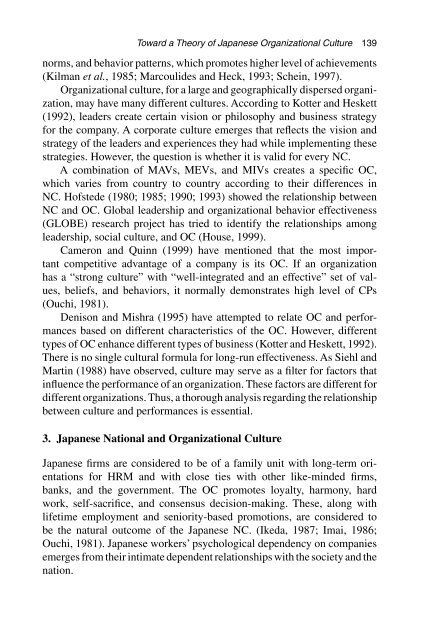Economic Models - Convex Optimization
Economic Models - Convex Optimization
Economic Models - Convex Optimization
Create successful ePaper yourself
Turn your PDF publications into a flip-book with our unique Google optimized e-Paper software.
Toward a Theory of Japanese Organizational Culture 139<br />
norms, and behavior patterns, which promotes higher level of achievements<br />
(Kilman et al., 1985; Marcoulides and Heck, 1993; Schein, 1997).<br />
Organizational culture, for a large and geographically dispersed organization,<br />
may have many different cultures. According to Kotter and Heskett<br />
(1992), leaders create certain vision or philosophy and business strategy<br />
for the company. A corporate culture emerges that reflects the vision and<br />
strategy of the leaders and experiences they had while implementing these<br />
strategies. However, the question is whether it is valid for every NC.<br />
A combination of MAVs, MEVs, and MIVs creates a specific OC,<br />
which varies from country to country according to their differences in<br />
NC. Hofstede (1980; 1985; 1990; 1993) showed the relationship between<br />
NC and OC. Global leadership and organizational behavior effectiveness<br />
(GLOBE) research project has tried to identify the relationships among<br />
leadership, social culture, and OC (House, 1999).<br />
Cameron and Quinn (1999) have mentioned that the most important<br />
competitive advantage of a company is its OC. If an organization<br />
has a “strong culture” with “well-integrated and an effective” set of values,<br />
beliefs, and behaviors, it normally demonstrates high level of CPs<br />
(Ouchi, 1981).<br />
Denison and Mishra (1995) have attempted to relate OC and performances<br />
based on different characteristics of the OC. However, different<br />
types of OC enhance different types of business (Kotter and Heskett, 1992).<br />
There is no single cultural formula for long-run effectiveness. As Siehl and<br />
Martin (1988) have observed, culture may serve as a filter for factors that<br />
influence the performance of an organization. These factors are different for<br />
different organizations. Thus, a thorough analysis regarding the relationship<br />
between culture and performances is essential.<br />
3. Japanese National and Organizational Culture<br />
Japanese firms are considered to be of a family unit with long-term orientations<br />
for HRM and with close ties with other like-minded firms,<br />
banks, and the government. The OC promotes loyalty, harmony, hard<br />
work, self-sacrifice, and consensus decision-making. These, along with<br />
lifetime employment and seniority-based promotions, are considered to<br />
be the natural outcome of the Japanese NC. (Ikeda, 1987; Imai, 1986;<br />
Ouchi, 1981). Japanese workers’ psychological dependency on companies<br />
emerges from their intimate dependent relationships with the society and the<br />
nation.
















